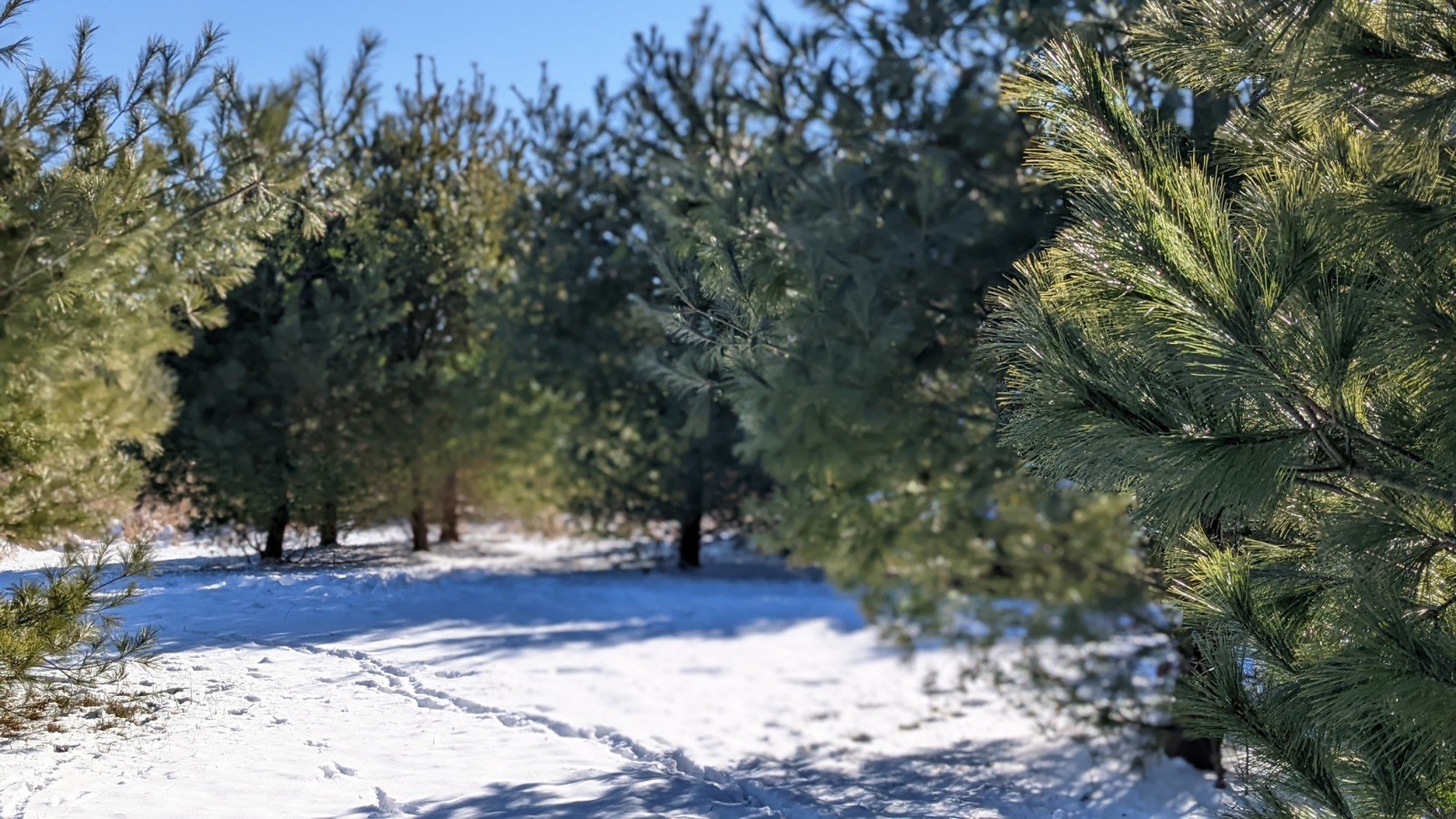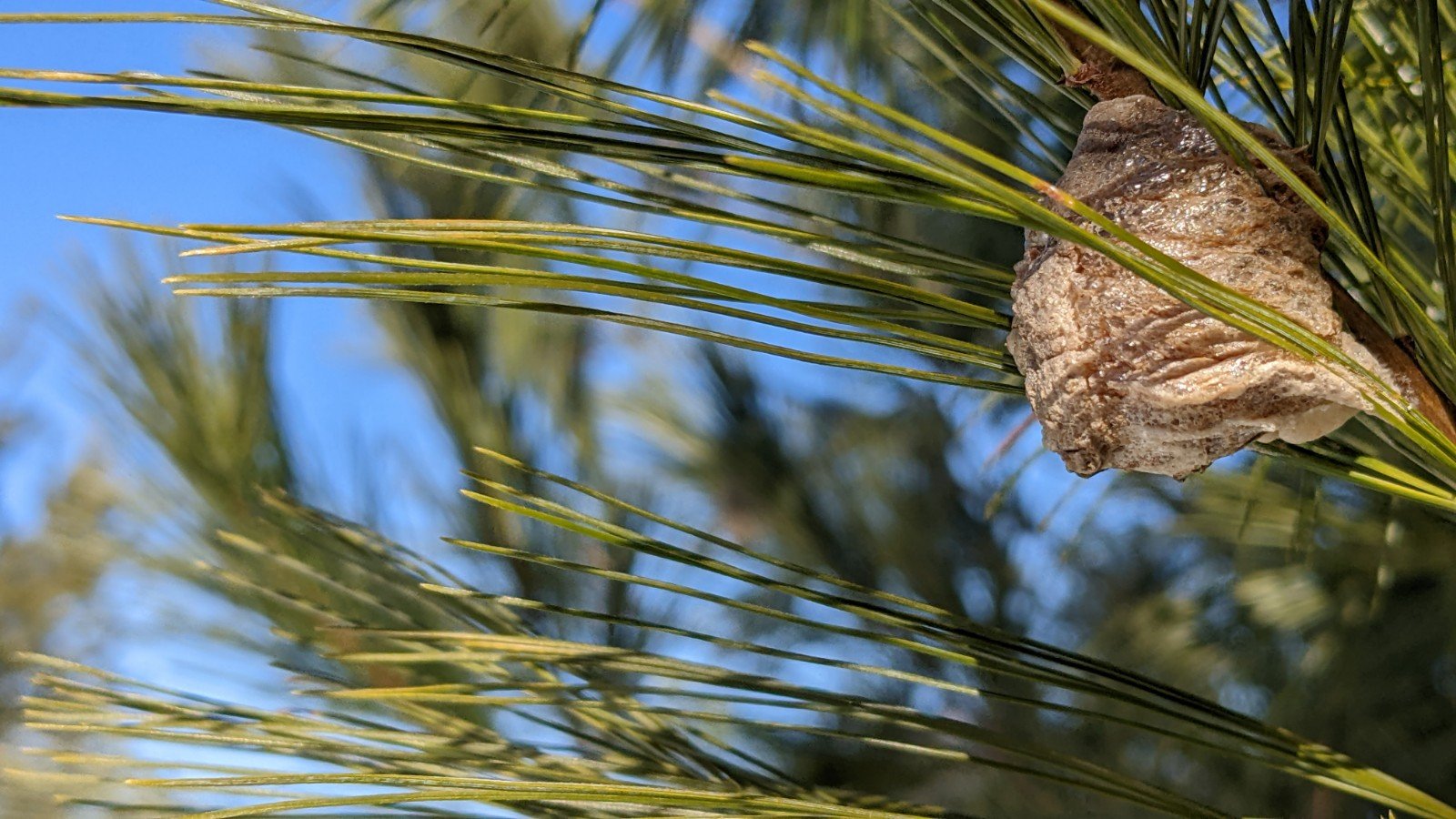Nestled in the river hills of the Susquehanna River, the Clark Nature Preserve, stewarded by the Lancaster Conservancy, is home to a diversity of ecosystems awaiting your exploration! The seeded meadow, with its circuitous wide trails, is exceptional to witness in the winter. The meadow is part of a reestablishment effort of predominately native grasses and a handful of forbs, where conventional agricultural fields once stood. The PA Game Commission and the National Wild Turkey Federation partnered with the Conservancy on this effort.
Meadow trail marker with wild bergamot seedheads (Monarda fistulosa) | Clark Nature Preserve in Pequea, PA, January 2022
Whether you explore by snow boots or cross-country ski boots, the paths pass by stark pops of textured seed-heads that catch your eye between the seas of high grass and early successional trees, their rarity forces you to pause <breathe>. The sunlight dancing between the tawny thatch, the varied sepia notes satisfying your warmed Winter soul, just as it does even on the most color poppin’ Summer day.
Wild bergamot and goldenrod species highlighted in a matrix of tall grasses and early successional trees | Clark Nature Preserve in Pequea, PA, January 2022
On this last snow boot adventure, the seed-heads of memorable note were the quintessential wild bergamot (Monarda fistulosa) pom-pom tufts, a scratch-n-sniff plant even in the depths of winter, hinting to soft oregano or earl grey tea. Common milkweed (Asclepias syriaca) graces the meadow at its entry. Purple coneflower (Echinacea purpurea) with evident signs of birds feasting on its sea-urchin seed-heads.
Common milkweed (Asclepias syriaca)
Purple coneflower (Echinacea purpurea)
All classic natives to incorporate into the land you are rewilding and stewarding, yet be warned that wild bergamot and common milkweed both need vast space to roam, given their high sociability level. Just like humans, plants are social organisms that interact with their neighboring plant kin or as defined by Encyclopedia.com, plant sociability is “a measure of the distribution pattern and organization of a species” (2018).
In my study with Claudia West, world renowned landscape designer with Phyto Studio, we practiced categorizing the sociability of common native landscaping plants into 5 levels, based on the Braun-Blanquet System.
Level 1: Isolated individual plants
Level 2: Occasionally present, less than 20% of observed landscape
Level 3: Small groups present, 20-40% of observed landscape
Level 4: More frequent patches, 40-60% of observed landscape
Level 5: Larger populations of higher density, 60-80% of observed landscape
In observation of the species seeded in this multi-acre meadow, there are level 5 grass species like Indian grass (Sorghastrum nutans), an “aggressive” grower that spreads via rhizomes. So, the highlighted flowering forbs that remain in this meadow are higher level on the sociability scale, simply because they are even present in a plant community of highly dispersive grass species, in a mature meadow such as this one.
Broomsedge (Andropogon virginicus) along the meadow trail | Kellys Run, Holtwood, PA, January 2022
Another example of a more broad spreading native grass species that happens to also have stellar winter interest is broomsedge (Andropogon virginicus).
Quick Quiz: From observing the image above, how would you classify the sociability of this grass meadow species? Do you observe a single specimen or over 50% present in this meadow?
Translating this to when ecological gardeners design their lawn conversion project, requires some time learning plants and how they interact with others. This does mean there will be a steep learning curve on your first plantings when you foolishly plant wild bergamot in a small space (less than 500 sq ft.) and expect it to mingle well with others. If creating a highly diverse landscape is your aim, choose native plants with lower sociability (take it from me, lesson learned on schoolyard habitat #1 :)). Also, embrace your clay soil, it helps to keep some of those higher level rhizomatic species a bit more at bay.
Eastern white pine grove (Pinus strobus)
Eastern white pine cone (Pinus strobus)
In the next layer of your ecosystem stroll, trees can be observed for their stunning winter interest at Clark Nature Preserve. A grove of Eastern white pine (Pinus strobus) appears to be intentionally planted along the edge of the meadow, as part of the Lancaster Conservancy’s effort with the Natural Resources Conservation Service’s (NRCS) Conservation Reserve Enhancement Program (CREP) to plant more native trees on the preserve.
A wonderful addition to add to your next lawn conversion project, if you have the space for this native evergreen at a mature height of 80’ and width of 40’. You’ll be full of gratitude in winter with its vivid green pop, fresh aromatics, and possibly an uplifting #homegrown #homebrew tea (if you don’t have pine allergies!).
Chinese mantid (Tenodera sinensis) egg case | Clark Nature Preserve in Pequea, PA, January 2022
An occasional pine cone is spotted and dozens of Chinese mantid (Tenodera sinensis) egg cases tucked into the needles. A reminder to first correctly ID, remove, then feed these cases to wild birds at your feeder station or local wild bird rehabilitation, or even treat your chickens or pet tarantula (!).
Allowing the egg cases to populate into hundreds of baby mantises will introduce an unbalanced number of apex predators into your landscape, greatly diminishing the amount of bees and butterflies on your property. These large praying mantis species eat bees and butterflies like a hungry teenager ravishingly eating a bowl chips. There is no shame, folks, its brutal to witness, especially when observed in your own labor-of-love #homegrownhabitat.
House Rock overlook | Clark Nature Preserve in Pequea, PA, January 2022
Sweet birch (Betula lenta)
Female seed structures
Female (left) and male (right)
A final winter interest inspiration was found on the House Rock outcropping, overlooking the stunning Susquehanna River. Lined up in a row, with the best views of the river, sat the upright female Sweet birch (Betula lenta) cone-like structures. When viewed up close, they look like baby pinecones and from a distance, delicate tree decorations. The sweetness of a nibbled twig end conjures up memories of rootbeer barrel candies and birchbeer soda, enjoyed from the Amish-owned corner grocer, as a kid visiting my “Oma -n- Opa” in Leola :).
Carex and ice crystals on House Rock overlook | Clark Nature Preserve, Pequea, PA, January 2022
Just as I thought I’d gathered all the winter interest inspirations from this adventure, the sight of this cool season sedge (Carex spp.) was tucked under a rock ledge with artful ice crystals catching the winter sun, casted over the river. Sedges are a must for an ecological garden, crucial as a living/green mulch and host to skipper butterflies. Given that they grow in the cooler seasons, they help tremendously in dampening the impact of winter weeds. A perfect pause to close this winter interest and sociability observation adventure, just enough to satisfy this Waxwing wandering :).
by Elyse Jurgen | Waxwing EcoWorks Owner/Founder
Are you also an ecological gardener on the prowl for a botanically rich observation adventure? Share your winter interest and plant sociability comments below and give this post some love. Thank you!













